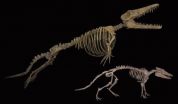(Press-News.org) A team of Brazilian physicists working with neuroscientists studying freely behaving rats have found that their neurons often act in precise coordination over time, in a study about to be published in EPJ B. These findings stem from the work of Bruno Silva, a researcher at Bahia Federal University in Salvador, and his colleagues from other universities in the Northeastern region of Brazil, and suggest that neuronal networks' memory could be explored in the future.
Because neurons are connected with each other, acting as operational units in the brain, they can be considered as a complex system. The authors thus relied on a theory traditionally used to study complex networks to confirm whether the firing frequency of a given neuron is correlated with that of other brain areas.
Silva and his colleagues constructed a model in which a network node represents a neuron and a network link is included between a pair of nodes whenever their firing rates are correlated. Instead of focusing on few large networks with thousands of nodes as studied by techniques such as magnetic resonance imaging, the authors prepared detailed statistics on the records of a large set (~10,000) of smaller networks.
They found that, irrespective of the behavioral state of the animal , the number of networks with highly correlated activity in distinct brain areas can be represented in a fat-tailed graph representing a widespread probability of such correlation happening. This suggests that such connectivity associated with a specific function of the brain persists over time. Thus, memories in neuronal functional networks could very well be investigated in the future.
Finally, the authors also realised that what remains nearly constant in the brain is not the actual function of individual neurons but aspects of the network structure itself.
###
Reference:
B. B. M. Silva, J. G. V. Miranda, G.Corso, M. Copelli, N. Vasconcelos, S. Ribeiro, R. F. S. Andrade (2012), Statistical characterization of an ensemble of functional neural networks, European Physical Journal B 85: 358, DOI: 10.1140/epjb/e2012-30481-7
For more information, please visit www.epj.org
The full-text article is available to journalists on request.
Persistent sync for neurons
Rats' neurons reveal steady neural network coordination regardless of the animals' behavior
2012-11-07
ELSE PRESS RELEASES FROM THIS DATE:
City birds adapt to their new predators
2012-11-07
Faced with the same threat, city and country birds do not react in the same way despite being from the same species. According to a new study, urban birds have changed their anti-predator behaviour in new environments.
When a bird is faced with a predator, its only objective is to escape. However, city birds do not react in the same way as their countryside counterparts, despite being from the same species. Urbanisation plays an influential role in their survival strategies.
To study this phenomenon, Juan Diego Ibáñez-Álamo, researcher at the University of Granada ...
Ultrasensitive photon hunter
2012-11-07
Fast and ultrasensitive optical systems are gaining increasing significance and are being used in a diverse range of applications, for example, in imaging procedures in the fields of medicine and biology, in astronomy and in safety engineering for the automotive industry. Frequently the challenge lies in being able to record high-quality images under extremely low light conditions. Modern photo detectors for image capture typically reach their limits here. They frequently work with light-sensitive electronic components that are based on CMOS (Complementary Metal Oxide ...
Dealing with power outages more efficiently
2012-11-07
Power supply is the backbone of our modern economy. Nearly every aspect of life depends on electrically-operated devices. When the flow of power stops, it is not just the lights that go out. In the supermarket, the automatic teller machines and cash registers stop working. Even telephones, radios and televisions become paralyzed. If the shortage lasts a long time the supply of hot water, gas and fuel and the functioning of respirators at intensive care units in nursing homes or at private homes is at risk.
The causes of this dreadful scenario can range from natural disasters ...
Activating the 'mind's eye' -- sounds, instead of eyesight can be alternative vision
2012-11-07
Jerusalem, Nov. 7, 2012 -- Common wisdom has it that if the visual cortex in the brain is deprived of visual information in early infanthood, it may never develop properly its functional specialization, making sight restoration later in life almost impossible.
Scientists at the Hebrew University of Jerusalem and in France have now shown that blind people – using specialized photographic and sound equipment – can actually "see" and describe objects and even identify letters and words.
The new study by a team of researchers, led by Prof. Amir Amedi of the Edmond and ...
Protected areas in East Africa may not be conserving iconic plants
2012-11-07
A new study led by researchers from the University of York suggests protected areas in East Africa are not conserving plants such as the iconic Acacia tree.
Acacia, the thorny flat-topped tree that characterises the African savannas, is an important component of ecosystem diversity. However, the researchers found that the majority of Acacia biodiversity 'hotspots' receive little protection through the protected area network, which includes national parks, nature and forest reserves. The situation, they say, may be exacerbated by climate change.
The results of the study, ...
Development of measures to prevent wine indispositions
2012-11-07
Biogenic amines may be one of the factors responsible for symptoms such as headaches, gastro-intestinal disorders, shortness of breath, fall in blood pressure, and even unconsciousness and cardiac arrhythmia in severe cases. Histamine, one of the best known members of this group, can cause serious physical problems. Biogenic amines can be produced in the body by natural metabolic activities but are also ingested in larger quantities with food. They play a special role in microbiologically produced food such as wine, beer, cheese, and sauerkraut. In a joint project Johannes ...
Recent studies bring fossils and genes together to piece together evolutionary history
2012-11-07
Paleontology, with its rocks and fossils, seems far removed from the world of developmental genetics, with its petri dishes and embryos. Whereas paleontology strives to determine "What happened in evolution?", developmental genetics uses gene control in embryos to try to answer "How did it happen?" Combined, the two approaches can lead to remarkable insights that benefit both fields.
In the current issue of the Journal of Vertebrate Paleontology, Hans Thewissen, Ingalls-Brown Professor at Northeast Ohio Medical University (NEOMED), and his colleagues review recent studies ...
New method could help communities plan for climate risk
2012-11-07
CAMBRIDGE, Mass. -- Climate scientists cannot attribute any single weather event — whether a drought, wildfire or extreme storm — to climate change. But extreme events, such as Hurricane Sandy, are glimpses of the types of occurrences the world could be more vulnerable to in the future. As the devastation left by Sandy continues to reverberate, decision-makers at every level are asking: How can we be better prepared?
MIT researchers have developed a new tool to help policymakers, city planners and others see the possible local effects of climate change. Its regional projections ...
Synthetic biofilter wins through to the top 'Sweet 16' in Boston
2012-11-07
This press release is available in German.
Months of painstaking work in the laboratory at Bielefeld University's Center for Biotechnology (CeBiTec) have paid off: the 15 students participating in this year's 'international Genetically Engineered Machine competition' (iGEM) at the Massachusetts Institute of Technology (MIT) have good reason to celebrate. The goal of their project was to develop a biological filter that removes estrogen from drinking water. It was a success: they managed to produce enzymes that break down the hormone. On Monday 5 November, the competition ...
Longer use of hormonal contraception during midlife predicts better cognitive function later
2012-11-07
New Rochelle, NY, November 7, 2012—Premenopausal use of hormonal contraceptives may improve the cognitive abilities of women in midlife and for years afterward. This finding may have implications for prevention of declining cognitive function that occurs with advancing age and in diseases such as Alzheimer's. The beneficial effects of hormones increase the longer a woman uses them, as described in a study published in Journal of Women's Health, a peer-reviewed publication from Mary Ann Liebert, Inc., publishers. The article is available free on the Journal of Women's Health ...
LAST 30 PRESS RELEASES:
Norbert Holtkamp appointed director of Fermi National Accelerator Laboratory
New agentic AI platform accelerates advanced optics design
Biologists discover neurons use physical signals — not electricity — to stabilize communication
Researchers discover that a hormone can access the brain by hitchhiking
University of Oklahoma researcher awarded funding to pursue AI-powered material design
Exploring how the visual system recovers following injury
Support for parents with infants at pediatric check-ups leads to better reading and math skills in elementary school
Kids’ behavioral health is a growing share of family health costs
Day & night: Cancer disrupts the brain’s natural rhythm
COVID-19 vaccination significantly reduces risk to pregnant women and baby
The role of vaccination in maternal and perinatal outcomes associated with COVID-19 in pregnancy
Mayo Clinic smartwatch system helps parents shorten and defuse children's severe tantrums early
Behavioral health spending spikes to 40% of all children’s health expenditures, nearly doubling in a decade
Digital cognitive behavioral treatment for generalized anxiety disorder
Expenditures for pediatric behavioral health care over time and estimated family financial burden
Air conditioning in nursing homes and mortality during extreme heat
The Alps to lose a record number of glaciers in the next decade
What makes a good proton conductor?
New science reporting guide published for journalists in Bulgaria
New international study reveals major survival gaps among children with cancer
New science reporting guide published for journalists in Turkey
Scientists develop a smarter mRNA therapy that knows which cells to target
Neuroanatomy-informed brain–machine hybrid intelligence for robust acoustic target detection
Eight SwRI hydrogen projects funded by ENERGYWERX
The Lundquist Institute and its start-up company Vitalex Biosciences Announces Strategic Advancement of Second-Generation fungal Vaccine VXV-01 through Phase 1 Trials under $40 Million Competitive Con
Fine particles in pollution are associated with early signs of autoimmune disease
Review article | Towards a Global Ground-Based Earth Observatory (GGBEO): Leveraging existing systems and networks
Penn and UMich create world’s smallest programmable, autonomous robots
Cleveland researchers launch first major study to address ‘hidden performance killer’ in athletes
To connect across politics, try saying what you oppose
[Press-News.org] Persistent sync for neuronsRats' neurons reveal steady neural network coordination regardless of the animals' behavior






